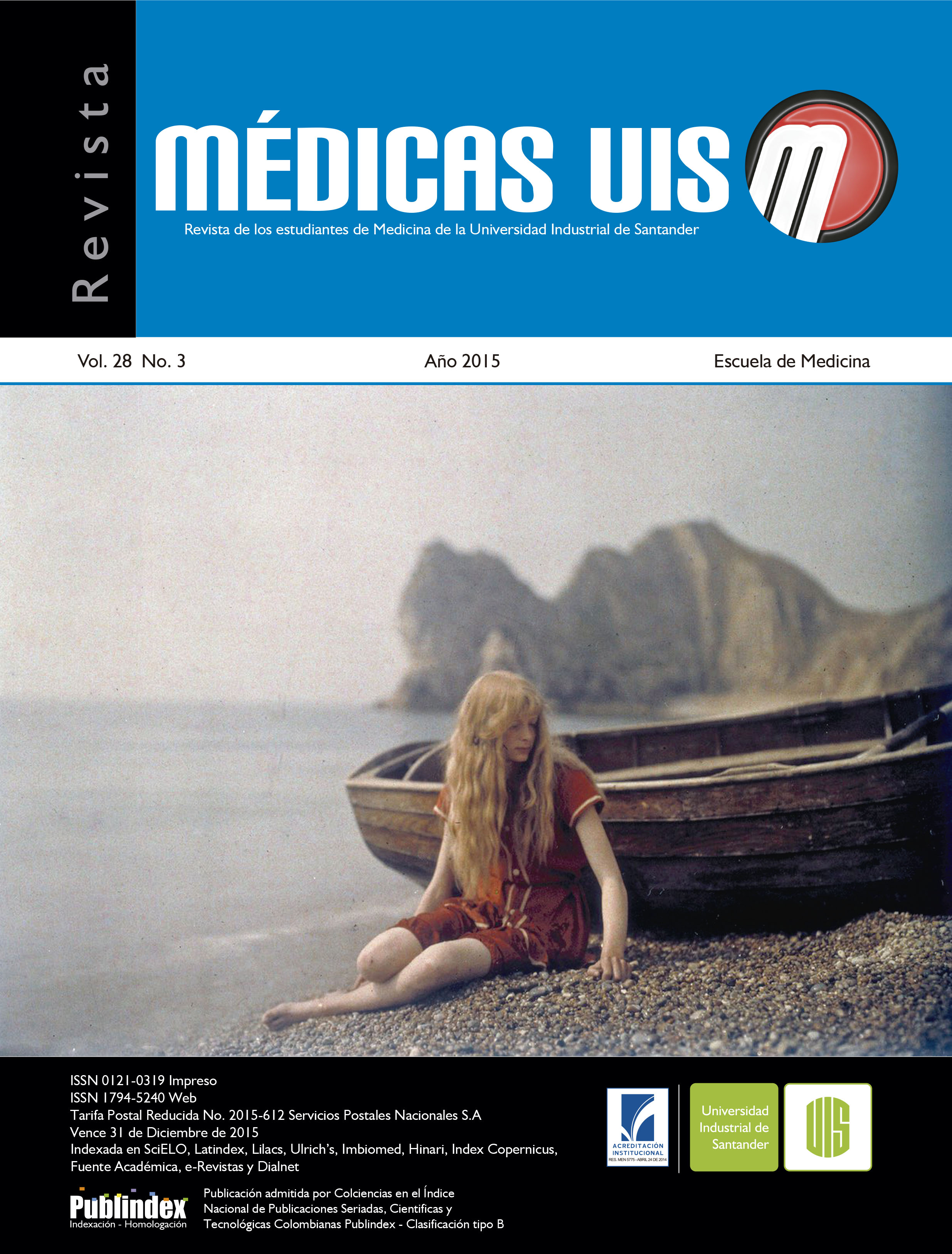Abstract
Introduction: Transplant patients are a challenge from every point of view. Infection with Epstein- Barr virus is common and management is often hampered by the lack of effective medicaments available. Liver transplant patients have a high incidence of Epstein-Barr virus
infection / reactivation because of the the risk of primary infection during this period or immunosuppression associated reactivation. Objectives: Describe the findings when using EBV viral load monitoring in liver transplant patients in an institution of the fourth level in Medellin, Colombia. Selection of patients: Seven medical records from liver transplant patients were randomly chosen obtaining from them demographic data, cause of transplantation, time of the Epstein-Barr virus detection, viral load evolution, effects of immunosuppressive medications over them and the patient´s outcome. Description of patients: Average patient age at transplant was 28,4 months, the effect of antiviral drugs (gangiclovir, valganciclovir, cytomegalovirus immunoglobulin) seems not to be adequate and sustained in decreasing viral load. Conclusions: Although the therapeutic options available for Herpes virus , as found in current literature and seen in our patients, immunosupression degree seems to be the main factor for controlling EBV replication. MÉD UIS. 2015;28(3):393-401.
Keywords: Epstein-Barr virus infections. Immunosupresion. Liver transplantation.
References
Jenson HB. Epstein-Barr Virus. Pediatrics in Review.2011;32(9):375-83;375-84.
Pordeus V, Barzilai O, Sherer Y, Luiz RR, Blank M, Bizarro N, et al. A latitudinal gradient study of common anti-infectious agent antibody prevalence in Italy and Colombia. Isr Med Assoc J. 2008;10(1):65-8.
De Roos AJ, Martinez-Maza O, Jerome KR, Mirick DK, Kopecky KJ, Madeleine MM, et al. Investigation of epstein-barr virus as a potential cause of B-cell non-Hodgkin lymphoma in a prospective cohort. Cancer Epidemiol Biomarkers Prev. 2013;22(10):1747-55. Epub 2013 Jul 24.
Slyker JA, Casper C, Tapia K, Richardson B, Bunts L, Huang ML, et al. Clinical and virologic manifestations of primary EpsteinBarr virus (EBV) infection in Kenyan infants born to HIV-infected women. J Infect Dis. 2013;207(12):1798-806. Epub 2013 Mar 14.
Tiao G, Alonso MH, Ryckman FC. Liver transplantation in children. In: Suchy FJ, Sokol RJ, Balistreri WF, editors. Liver disease in children. 18a Ed. UK: Cambridge University Press; 2007. p. 975-93.
Green M, Michaels MG. Epstein-Barr virus infection and posttransplant lymphoproliferative disorder. Am J Transplant. 2013;13 Suppl 3:41-54; quiz 54.
Wiederkehr JC, Coelho IM, Avilla SG, e Silva EM, Schuller S, Ouno DD, et al. Prevalence of posttransplantation lymphoproliferative disease in pediatric liver transplant recipients. Transplant Proc. 2010;42(2):521-2.
Martelius T, Lappalainen M, Aalto SM, Nihtinen A, Hedman K, Anttila VJ. Clinical characteristics, outcome and the role of viral load in nontransplant patients with Epstein-Barr viraemia. Clin Microbiol Infect. 2010;16(6):657-62.
Allen U, Alfieri C, Preiksaitis J, Humar A, Moore D, Tapiero B, et al. Epstein-Barr virus infection in transplant recipients: Summary of a workshop on surveillance, prevention and treatment. Can J Infect Dis. 2002;13(2):89-99.
Ozçay F, Arslan H, Bilezikçi B, Sevmiş S, Moray G, Haberal M. The role of valacyclovir on Epstein-Barr virus viral loads in pediatric liver transplantation patients. Transplant Proc. 2009;41(7):2878-80.
Qiagen (2012). QIAamp® DNA Mini and Blood Mini Handbook. 3th Ed.
Narkewicz MR, Green M, Dunn S, Millis M, McDiarmid S, Mazariegos G, et al. Decreasing incidence of symptomatic EpsteinBarr virus disease and posttransplant lymphoproliferative disorder in pediatric liver transplant recipients: report of the
studies of pediatric liver transplantation experience. Liver Transpl. 2013;19(7):730-40.
Scheenstra R, Verschuuren EA, de Haan A, Slooff MJ, The TH, Bijleveld CM, et al. The value of prospective monitoring of Epstein-Barr virus DNA in blood samples of pediatric liver transplant recipients. Transpl Infect Dis. 2004;6(1):15-22.
Jang JY, Kim KM, Lee YJ, Lee SG, Chi HS. Quantitative EpsteinBarr virus viral load monitoring in pediatric liver transplantation. Transplant Proc. 2008;40(8):2546-8.
Lee TC, Savoldo B, Rooney CM, Heslop HE, Gee AP, Caldwell Y, et al. Quantitative EBV viral loads and immunosuppression alterations can decrease PTLD incidence in pediatric liver transplant recipients. Am J Transplant. 2005;5(9):2222-8.
Kasztelewicz B, Jankowska I, Pawlowska J, Teisseyre J, Grenda R, Pronicki M, et al. Epstein-Barr virus DNA load in peripheral blood mononuclear cells and whole blood from pediatric transplant recipients. Transpl Infect Dis. 2011;13(5):471-9.
Kimura H, Ito Y, Suzuki R, Nishiyama Y. Measuring Epstein-Barr virus (EBV) load: the significance and application for each EBVassociated disease. Rev Med Virol. 2008 ;18(5):305-19.
San-Juan R, De Dios B, Navarro D, García-Reyne A, Lumbreras C, Bravo D, et al. Epstein-Barr virus DNAemia is an early surrogate marker of the net state of immunosuppresion in solid organ transplant recipients. Transplantation. 2013;95(5):688-93.
Höcker B, Fickenscher H, Delecluse HJ, Böhm S, Küsters U, Schnitzler P, et al. Epidemiology and morbidity of EpsteinBarr virus infection in pediatric renal transplant recipients: a multicenter, prospective study. Clin Infect Dis. 2013;56(1):84-92.
Green M, Soltys K, Rowe DT, Webber SA, Mazareigos G. Chronic high Epstein-Barr viral load carriage in pediatric liver transplant recipients. Pediatr Transplant. 2009;13(3):319-23.
Orentas RJ, Schauer DW, Ellis FW, Walczak J, Casper JT, Margolis DA. Monitoring and modulation of Epstein-Barr virus loads in pediatric transplant
patients. Pediatr Transplant. 2003;7(4):305-14.
Catalán P, Alba A. Prophylaxis against Epstein Barr disease in pediatric and adult patients undergoing solid organ and hematopoietic stem cells transplantation. Rev Chilena Infectol. 2012;29Suppl 1:S29-31.
Venturi C, Bueno J, Gavalda J, Tórtola T, Pou L, Medina A, et al. Impact of valganciclovir on Epstein-Barr Virus polymerase chain reaction in pediatric liver transplantation: preliminary report. Transplant Proc. 2009;41(3):1038-40.
Hierro L, Díez-Dorado R, Díaz C, De la Vega A, Frauca E, Camarena C, et al. Efficacy and safety of valganciclovir in livertransplanted children infected with Epstein-Barr virus. Liver Transpl. 2008;14(8):1185-93.
Hayashida M, Ogita K, Matsuura T, Takahashi Y, Nishimoto Y, Ohga S, et al. Successful prolonged rituximab treatment for post-transplant lymphoproliferative disorder following living donor liver transplantation in a child. Pediatr Transplant.
;11(6):671-5.
Kamdar KY, Rooney CM, Heslop HE. Posttransplant lymphoproliferative disease following liver transplantation. Curr Opin Organ Transplant. 2011;16(3):274-80.
Allen U, Barton M, Beyene J, Hu P, Khodai-Booran N, Hébert D, et al. Gene expression using microarrays in transplant recipients at risk of EBV lymphoproliferation after organ transplantation: preliminary proof-of-concept. Pediatr Transplant. 2009;13(8):990-8.
